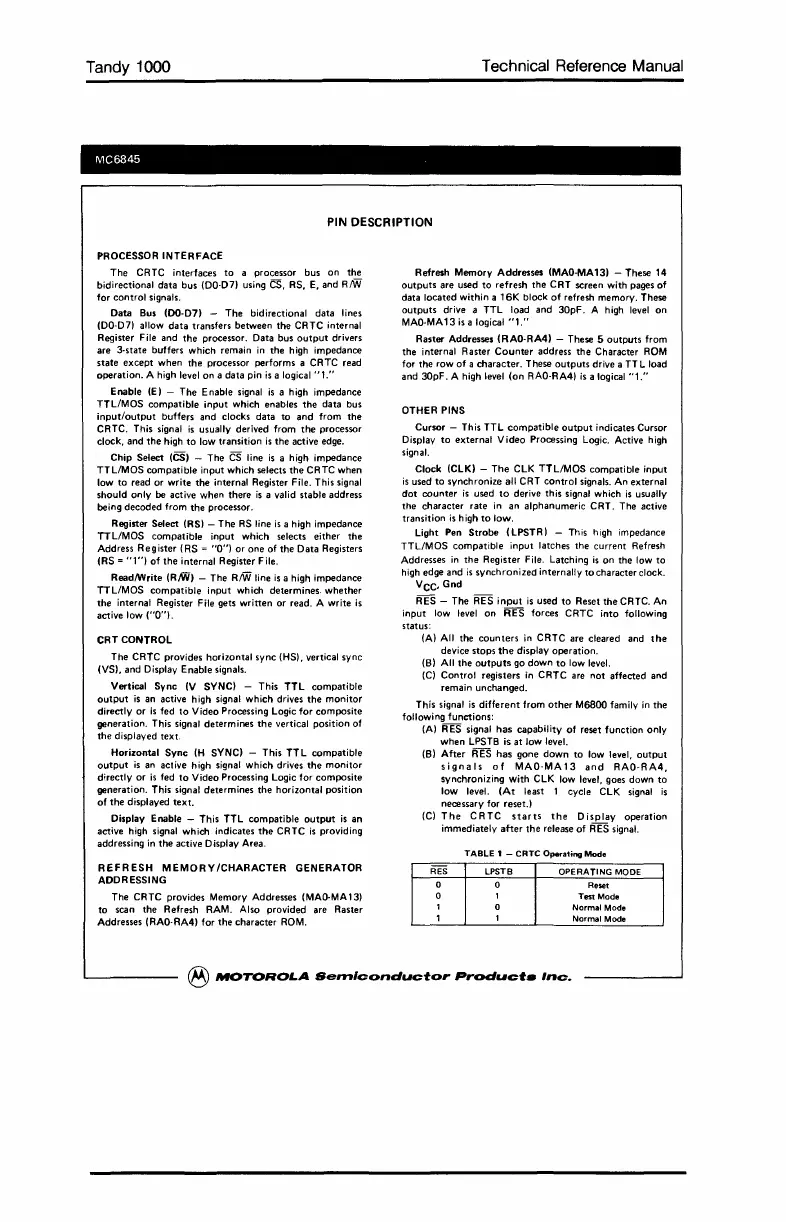Tandy 1000
MC6845
PIN
DESCRIPTION
Technical Reference Manual
PROCESSOR INTERFACE
The
CRTC interfaces
to
a processor bus
on
the
bidirectional data bus
(00·07)
using
CS,
RS,
E,
and RIW
for
control
signals.
Data Bus
(00-07)
-
The
bidirectional data lines
(00·07)
allow
data
transfers between
the
CRTC internal
Register File and
the
processor. Data bus
output
drivers
are 3-state buffers which remain
in
the
high impedance
state
except
when
the
processor performs a CRTC read
operation.
A high level
on
a
data
pin
is
a
logical"
1."
Enable (EI -
The
Enable signal
is
a high impedance
TTL/MOS
compatible
input
which enables
the
data bus
input/output
buffers and clocks data
to
and
from
the
CRTC. This signal
is
usually derived from
the
processor
clock, and
the
high
to
low transition
is
the
active edge.
Chip Select
(CS)
- The
CS
line
is
a high impedance
TTL/MOS
compatible
input which selects
the
CRTC when
low
to
read
or
write
the
internal Register File. This signal
should
only
be active when there
is
a valid stable address
being decoded from
the
processor.
Register Select (RSI - The
RS
line
is
a high impedance
TTL/MOS
compatible
input which selects
either
the
Address
Register
(RS =
"0")
or
one of
the
Data Registers
(RS
=
"1"1
of
the
internal Register File.
ReadlWrite
(RM)
- The RIW line
is
a high impedance
TTL/MOS
compatible
input
which determines.
whether
the
internal Register File gets
written
or
read. A write
is
active low
("0").
CRT CONTROL
The CRTC provides horizontal sync (HSI, vertical sync
(VS), and Display Enable signals.
Vertical
Sync
(V
SYNC) - This TTL
compatible
output
is
an active high signal
which
drives
the
monitor
directly
or
is
fed
to
Video Processing
logic
for
composite
generation. This signal determines
the
vertical position of
the
displayed text.
Horizontal
Sync
(H
SYNC) - This
TTL
compatible
output
is
an active high signal
which
drives
the
monitor
directly
or
is
fed
to
Video Processing
logic
for composite
generation. This signal determines
the
horizontal position
of
the
displayed
text.
Display Enable - This TTL
compatible
output
is
an
active high signal which indicates
the
CRTC
is
providing
addressing in
the
active 0 isplay Area.
REFRESH
MEMORY/CHARACTER
GENERATOR
ADDRESSING
The CRTC provides Memory Addresses (MAQ-MAI31
to
scan
the
Refresh RAM. Also provided are Raster
Addresses (RAO·RA41 for
the
character ROM.
Refresh Memory Addresses (MAO-MA131 - These 14
outputs
are used
to
refresh
the
CRT screen with pages
of
data located within a
16K
block
of
refresh memory. These
outputs
drive a TTL load and
30pF.
A high level on
MAO·MA13
is
a logical
"1."
Raster Addresses (RAO-RA4) - These 5
outputs
from
the internal Raster
Counter
address
the
Character
ROM
for the row
of
a
character.
These
outputs
drive a
TT
L load
and 3OpF. A high level (on RAO·RA4)
is
a logical
"1."
OTHER PINS
Cursor - This TTL
compatible
output
indicates Cursor
Display
to
external
Video
Processing Logic. Active high
signal.
Clock
(ClK)
-
The
ClK
TTL/MaS
compatible
input
is
used
to
synchronize all CRT
control
signals. An external
dot
counter
is
used
to
derive this signal which
is
usually
the
character rate
in
an alphanumeric CRT. The active
transition
is
high
to
low.
Light Pen
Strobe
(lPSTR
I - This high impedance
TTL/MOS
compatible
input
latches the current Refresh
Addresses
in
the
Register File. Latching
is
on
the low
to
high edge and
is
synchronized
internally
to
character clock.
VCC.
Gnd
RES - The RES
input
is
used
to
Reset
the
CRTC. An
input
low level
on
RES
forces CRTC
into
following
status:
(A) All the
counters
in
CRTC are cleared and
the
device stops
the
display operation.
(BI
All the
outputs
go
down
to
low level.
(C)
Control registers
in
CRTC are
not
affected and
remain unchanged.
This signal
is
different
from
other
M6800 family
in
the
following functions:
(AI RES signal
has
capability
of
reset function only
when
lPSTB
is
at
low level.
(B)
After
RES
has
gone
down
to
low level,
output
signals
of
MAO·MAI3
and
RAO·RA4,
synchronizing
with
ClK
low level, goes down
to
low level.
(At
least 1 cycle
ClK
signal
is
necessary for reset.)
(C)
The
C R TC
starts
the
0
isplay
operation
immediately
after
the
release
of
RES signal.
TABLE
1 - CRTC Operating
Mode
RES LPSTB
OPERATING
MODE
0
0
Reset
0
1
Test Mode
1
0
Normal Mode
1
1
Normal Mode
®
MOTOROLA
Senl'conductor
Product.
Inc.
